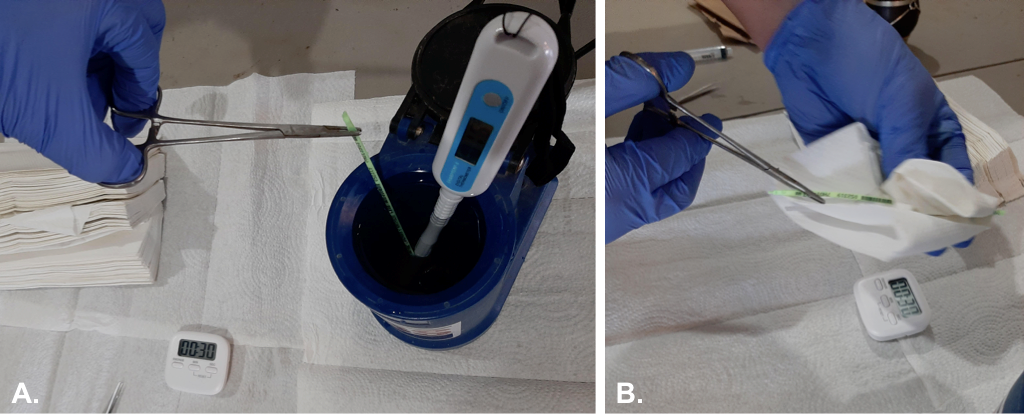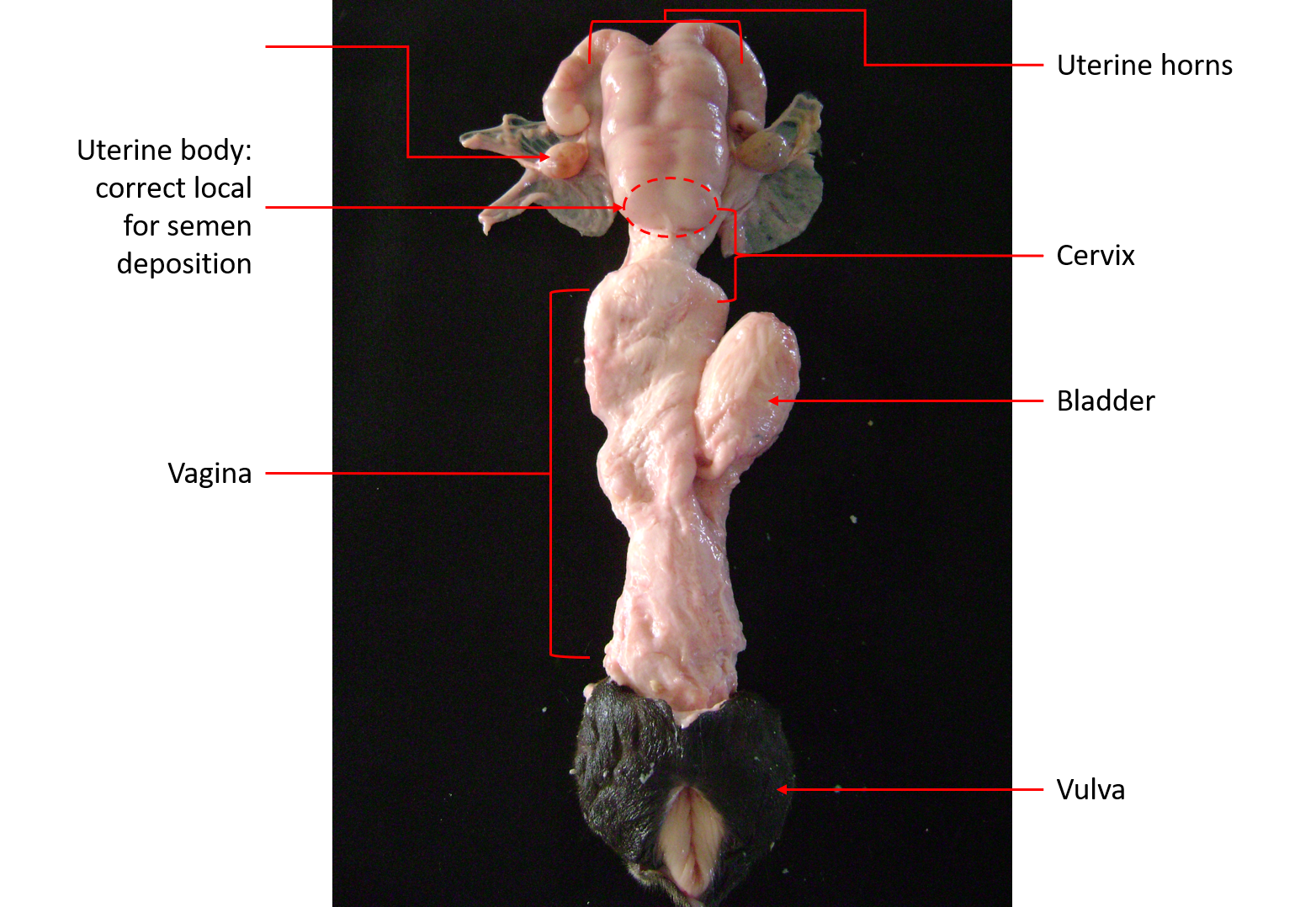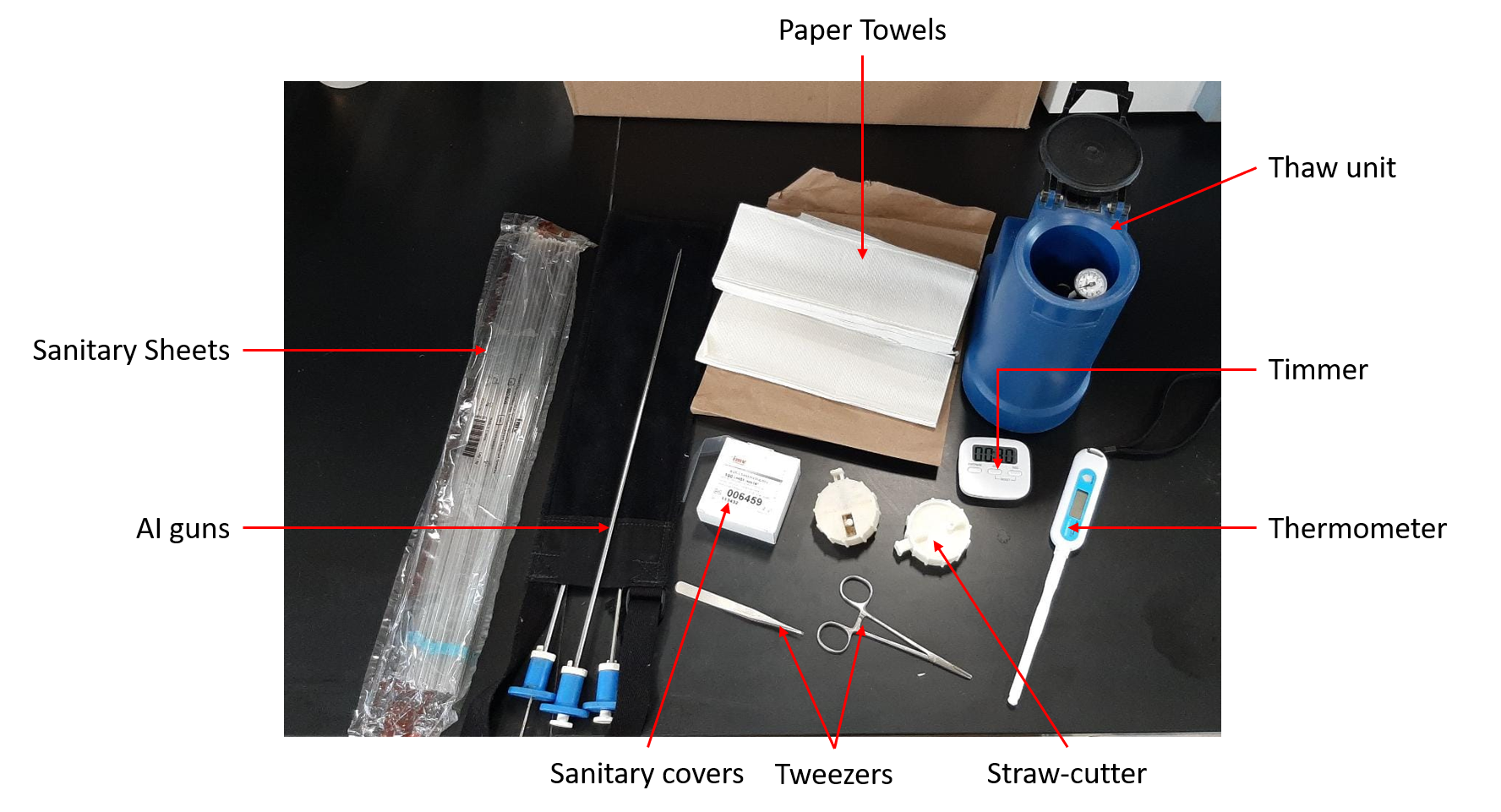Daniela Cortés-Beltrán & Angela Gonella D. DVM, PhD., North Florida Research and Education Center, Reproduction Lab
Introduction
Artificial Insemination (AI) is an Assisted Reproductive Technology (ART) used worldwide to deposit stored semen directly into a cow or heifer’s uterus. It is a tool for improving reproductive performance and genetic quality of livestock. This technique is frequently used in the dairy and beef cattle industries as a way to more rapidly improve desired characteristics through intensive genetic selection. AI has significant advantages, such as facilitating the use of superior quality sires (without the expense and risk of ownership) and greatly reducing the risk of introducing venereal diseases into the herd (Fontes, Oosthuizen, & Cliff Lamb, 2020; Noackes et al., 2001; Vishwanath, 2003). It is important to emphasize that closely following the recommended protocol is essential for the process to be successful. The objective of this article is to offer tips for successful utilization of AI on your operation.
–
AI Kit and Hygiene
The basic insemination kit should contain a stainless-steel AI gun, straw cutter or scissors, tweezers, non-spermicidal lubricant, thermometer, and thaw unit (water bath or wide-mouth thaw thermos). In addition, disposable supplies like split plastic sheaths, sanitary covers, plastic palpation gloves, and paper towels (Figure 1). The AI kit must be stored in a dry, dust-free, clean place. It is important to clean the kit before and after performing AI.
–
Liquid Nitrogen Tank Management
A periodic check of the liquid nitrogen levels in the tank is necessary to guarantee that the straws are completely immersed. Always remember that liquid nitrogen can cause cold-burn injury to operators, if not handled carefully. The tank should be stored in a clean, dry, and well-ventilated place. The tank must be protected from corrosive and wet surfaces, so it is recommended to keep it elevated off of the ground using cardboard or wooden pallets. Also, it is very important to maintain an inventory list with complete information of the semen stored inside the tank, facilitating quick location with limited handling of the straws in the tank.
–
Semen Handling
It is crucial to handle semen properly once the straw is removed from the liquid nitrogen tank. You want to keep the canister, cane, and unused straws as close to the neck of the tank as possible for no more than 5 – 8 seconds, avoiding exposure to high temperatures, which promotes thermal damage (Figure 2A).
Straw extraction should be done below the lower half of the neck of the storage tank, where the temperature is sufficiently cold (-120º C (-184º F)) (Hopper, 2015). To avoid this risk, it is crucial to have efficient handling to minimize the time of exposure outside of the tank, to maintain frozen semen quality. This is why it is important to handle the straws with tweezers instead of your fingers to prevent thermal damage to the semen and also avoid possible injury to the operator (Figure 2B).

Figure 2. Proper semen handling technique. A. Straw removal near to the neck of the storage tank. B. Use of tweezers and gloves for operator safety.
–
Another main issue is the correct semen thawing procedure; thawing needs occur rapidly and at the correct temperature. According to The National Association of Animal Breeders is appropriate to use 30 – 35º C (90 – 95º F) for a minimum of 30 seconds. Always use a water bath or a wide-mouth thaw thermos with a thermometer for accurate temperature monitoring (Figure 3A). It is also a good idea to use a timer to count 30 – 60 seconds before removing the straw from the thaw unit.
Once the straw is thawed, semen should be deposited into the uterus within 15 minutes. Lower conception rates can result from semen straws kept in the water bath too long, or from extended exposure to the environment waiting to be deposited in the uterus (Duponte, 2007). So, unless you are using experienced AI-technician who can breed multiple cows within this 15 minute time period, it is recommended to only thaw one or two straws at a time.
After thawing, the straw should be:
- Dried with a paper towel to remove all water (highly spermicidal agent; Figure 3B).
- Protected from direct sunlight or UV light (sperm cell damage)
- Protected from drastic temperature changes, which causes thermal shock (decreased motility).

Figure 3. Semen thawing process. A. Water temperature monitoring with time control for proper thawing. B. Correct straw drying.
–
The AI gun should be warmed by stroking it with a clean paper towel, or placing close to the body before inserting the straw to avoid thermal shock. Also, when loading the semen gun, it is essential to:
- Make sure the AI gun plug is retracted to allow the insertion of the straw.
- Insert the straw with cotton plug end first.
- Do a perpendicular straight cut (not at an angle) on the sealed side, with a clean-sharp straw cutter or scissors, to have a good fit with the sanitary sheath.
- Slide and attach the split plastic sheath and lock it with the AI gun firmly, then check for a proper seal.
- Protect the sheath with a sanitary sheath to prevent contact between AI sheath and animal’s vagina, to reduce the risk of uterine bacteria contamination.
- Keep the loaded AI gun warm and isolated from dirty surfaces until it is used.
–
Proper Insemination Technique
In cattle, AI is performed using a recto-vaginal technique. It is necessary that the operator is previously trained in this technique, although it is not difficult, it requires some skills and training to guarantee good results. Proper semen gun handling and the ability to deposit the semen in the correct location inside the uterus are vital (Diskin & Kenny, 2016).
Before starting:
- It is necessary to check that all the supplies are ready to begin the AI procedure
- The operator should wear clean protective clothing and must have trimmed short finger nails.
- Pay close attention to the hygiene of the animal’s perineal area to avoid contamination of the reproductive tract with pathogens.
First, it is required to restrict the animal as carefully and gently as possible before insemination to minimize stress. Then, the vulva region must be cleaned. Use a paper towel to remove feces, to prevent contamination and a possible infection in the uterus, which must be a sterile environment.
Use one disposable plastic palpation glove per animal with enough non-spermicidal lubricant to gently enter the anus to reach the rectus. Once your arm is inside, open the vulval lips while applying pressure on the rectum with the arm, to allow the entry of the insemination gun. The AI gunt should be inserted at a 30 – 40º angle into the vulva, to avoid entrance through the urethral opening into the bladder, situated on the vaginal floor.
To perform the recto-vaginal AI method, it is essential to hold the cervix through the rectum to direct the insemination gun forward into the vagina until it reaches the opening of the cervix. Next, it is necessary to dodge the fornix of the vagina and direct the insemination gun into the cervix by manipulation through the rectal wall. Once reached, the sanitary cover must be ripped to enter into the cervix, there will be a characteristic gritty sensation, and the cervix rings must be passed. As a result, the animal is going to be inseminated with a low and gentle motion into the uterine body, just 1 – 2 cm from the entrance of internal opening of the cervix (Noakes et al., 2001).
–
Semen Placement
Proper placement of semen in the uterine body improves pregnancy rates per insemination. It has been reported that cervical insemination errors occur in about 20% of attempted uterine body deposits (Diskin & Kenny, 2016). Also, it is essential not go too deep into one of the uterine horns, because of the high risk of depositing the semen in the wrong uterine horn for ovulation (Figure 5; Noakes et al., 2001).

Figure 4: Reproductive tract of the cow. Original photo courtesy of Dr. Cláudia Maria Bertan Membrive.
–
Take Home Message
Multiple variables impact artificial insemination success in cattle, and it is very important to pay attention to the details. Consult with your veterinarian or local extension agent before implementing an artificial insemination program on your operation. You can combine AI with estrous synchronization protocols, which allow you to used timed-AI to breed groups of animals all at the same time.
References
Diskin, M. G., & Kenny, D. A. (2016). Managing the reproductive performance of beef cows. Theriogenology, 86(1), 379–387.
Duponte, M. W. (2007). Proper Semen Handling During an Artificial Insemination Program, (April). Livestock Management:
Fontes, P. L. P., Oosthuizen, N., & Cliff Lamb, G. (2020). Reproductive management of beef cattle. Animal Agriculture, 57–73.
Noakes, D. E., Parkinson, T. J., England, G.C.W. & Arthur, G. (2001). Artificial insemination. In Arthur’s Veterinary Reproduction and Obstetrics, 8th Ed, W.B. Saunders, 751-778.
Vishwanath, R. (2003). Artificial insemination: The state of the art. Theriogenology, 59(2), 571–584.
- Heat Stress and its Impact on Cattle Reproduction - March 14, 2025
- Fall is Here.Time for Pregnancy Testing Cattle! - September 13, 2024
- How Stress Impacts Cattle Reproduction - March 15, 2024

